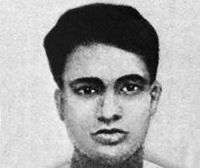Dinesh Gupta
Dinesh Chandra Gupta (Bengali: দিনেশ চন্দ্র গুপ্ত Dinesh Chôndro Gupto) or Dinesh Gupta (6 December 1911 – 7 July 1931) was an Indian revolutionary against British rule in India, who is noted for launching an attack on the Secretariat Building - the Writers' Building in the Dalhousie square in Kolkata, along with Badal Gupta and Benoy Basu.
Dinesh Chandra Gupta | |
|---|---|
দিনেশ চন্দ্র গুপ্ত | |
 | |
| Born | 6 December 1911 |
| Died | 7 July 1931 (aged 19) |
| Nationality | Indian |
| Citizenship | British Indian |
| Alma mater | Dhaka College |
| Known for | Writers' Building attack |
| Memorials |
|---|
Early activities
Dinesh Gupta was born on 6 December 1911 in Josholong in Munshiganj District, now in Bangladesh.[1] While he was studying in Dhaka College, Dinesh joined Bengal Volunteers - a group organised by Subhas Chandra Bose in 1928, at the occasion of Calcutta session of the Indian National Congress. Soon the Bengal Volunteers transformed itself to a more active revolutionary association and planned to kill infamous British police officers. For a short while, Dinesh Gupta was in Midnapore training local revolutionaries in the use of firearms. Revolutionaries trained by him were responsible for the assassination of three District Magistrates in succession, Douglas, Burge, and Peddy.
The battle of Writers' Building
The association targeted Col NS Simpson, the Inspector General of Prisons, who was infamous for the brutal oppression of the prisoners in the jails. The revolutionaries decided not only to murder him, but also to strike a terror in the British official circles by launching an attack on the Secretariat Building - the Writers' Building in the Dalhousie Square in Kolkata.
On 8 December 1930, Dinesh, along with Benoy Basu and Badal Gupta, dressed in European costume, entered the Writers' Building and shot dead Simpson. Nearby police started firing at them in response. What ensued was a brief gunfight between the 3 young revolutionaries and the police. Some other officers like Twynam, Prentice, and Nelson suffered injuries during the shooting.
Soon police overpowered them. However, the three did not wish to be arrested. Badal Gupta took Potassium cyanide, while Benoy and Dinesh shot themselves with their own revolvers. Benoy was taken to the hospital where he died on 13 December 1930.
The trial and hanging
However, Dinesh survived the near-fatal injury. He was convicted and sentenced to death.
While in Alipore Jail, he wrote letters to his sister which were later compiled into the book 'Ami Shubhash Bolchhi'. He was hanged on 7 July 1931 at Alipore Jail. Soon after that, Kanailal Bhattacharjee took revenge for the hanging by killing Mr. Gerlick (the judge of the Dinesh Gupta case) on 27 July 1931.[2]
Writings
Dinesh Gupta translated a short story of Anton Chekhov which was published in Prabasi Magazine. He also wrote 92 letters from the condemned cell of the Alipur Central Jail.[2][3]
Significance
Benoy, Badal, and Dinesh were treated as martyrs by supporters in Bengal and other parts of India. After independence, Dalhousie Square was named B. B. D. Bagh - after the Benoy-Badal-Dinesh trio. In memory of their writers' attack, a plate was engraved in the wall of Writers' Building, first floor.

Bibliography
- Hemendranath Dasgupta, Bharater Biplab Kahini, II & III, Calcutta, 1948;
- Ramesh Chandra Majumdar, History of the Freedom Movement in India, III, Calcutta 1963;
- Ganganarayan Chandra, Abismaraniya, Calcutta, 1966.
References
- Mohanta, Sambaru Chandra (2012). "Gupta, Dinesh Chandra". In Islam, Sirajul; Jamal, Ahmed A. (eds.). Banglapedia: National Encyclopedia of Bangladesh (Second ed.). Asiatic Society of Bangladesh.
- Prithwish C. Gupta (2016). Shahid Dinesh (Bengali). Kolkata: Shrayan. p. 81. ISBN 978-81-926712-6-0.
- AMIT ROY (15 June 2008). "Hanged Bengali icon's great-niece bags MBE". telegraphindia.com. Retrieved 2 August 2017.